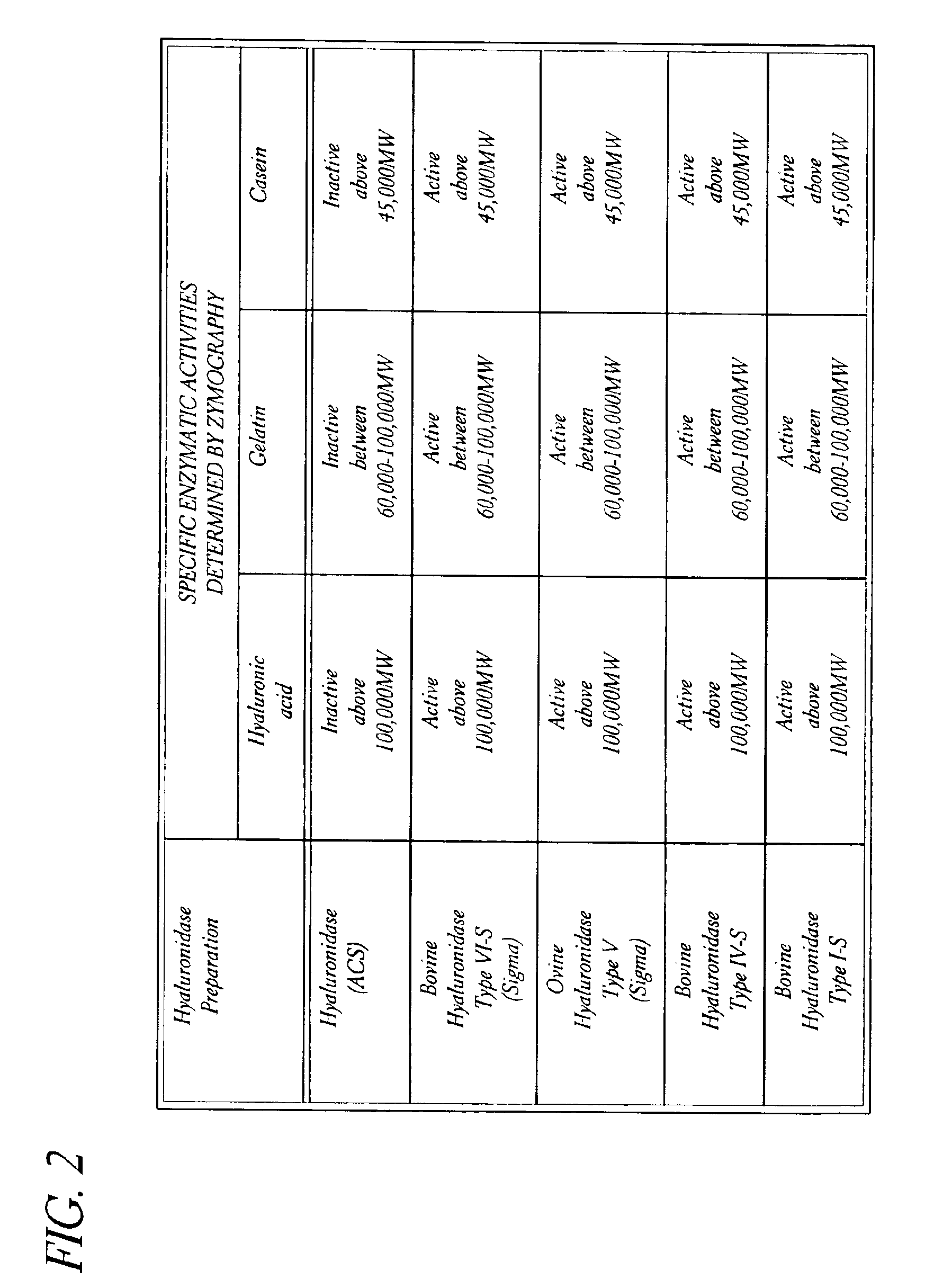Hyaluronidase preparation for ophthalmic administration and enzymatic methods for accelerating clearance of hemorrhagic blood from the vitreous body of the eye
a technology of hyaluronidase and ophthalmic administration, which is applied in the direction of peptide/protein ingredients, inorganic non-active ingredients, extracellular fluid disorder, etc., can solve the problems of loss of vision, further intravitreal hemorrhage and/or the formation of fibrous tissue at the site of hemorrhage, and undesirable fibrous attachment between the two, so as to accelerate the clearance of hemorrhagic blood and accelerate the effect o
- Summary
- Abstract
- Description
- Claims
- Application Information
AI Technical Summary
Benefits of technology
Problems solved by technology
Method used
Image
Examples
examples i
Ophthalmic Toxicities of Thimerosal, Hyaluronidase (ACS) and Hyaluronidase (Wydase®) in Rabbits
[0072]Fifty-Two (52) healthy rabbits of the New Zealand Cross variety (26 male, 26 female) weighing 1.5 kg to 2.5 kg, were individually marked for identification and were housed individually in suspended cages. The animals received a commercially available pelleted rabbit feed on a daily basis, with tap water available ad libitum.
[0073]The animals were divided into thirteen groups of 4 animals each (2 male, 2 female). Two animals in each group (1 male, 1 female) were selected for pretreatment fundus photography and fluorescein angiography.
[0074]The fundus photography was performed by restraining the animals and visualizing the optic nerve, retinal arcades and fundas with a KOWA® RC-3 Fundus Camera loaded with Kodak Gold 200 ASA film.
[0075]The fluorescein angiography involved a 1.5 ml injection of 2% sterile fluorescein solution via the marginal ear vein. Approximately 30 seconds post-injec...
example ii
Safety and Efficacy of Hyaluronidase (ACS) Injected Intravitreally in Rabbit Eyes
[0093]In this example, 12 healthy rabbits of the New Zealand Cross variety were marked for identification and individually housed in suspended cages. The animals received commercially pelleted rabbit feed on a daily basis and tap water was available ad libitum.
[0094]The animals were randomly divided into four (4) treatment groups of three (3) animals each.
[0095]Initially, the eyes of each animal were examined by dilation with 1-2 drops of 10% Tropicanide followed by gross examination, indirect ophthalmoscopy using a 20 diopter lens, and slit lamp examination of the anterior anatomy of the eye.
[0096]Following the initial examination of the animals eyes, 100 μl or 10 μl of blood was injected intravitreally into each eye of each animal.
[0097]On day 2, the animals of each treatment group received a single intravitreal injection of either BSS or Hyaluronidase (ACS) into the right eye, in accordance with the ...
example iii
Hemorrhage Clearing Efficacy of Hyaluronidase (ACS) in Humans
[0105]In this experiment, six (6) human patients (5 female, 1 male) who presented with intravitreal hemorrhage were treated with single intravitreal injections of Hyaluronidase (ACS) at dosages of 50-200 I.U.
[0106]The Hyaluronidase (ACS) administered in this experiment was prepared by the preferred formulation described hereabove and shown in Table II.
[0107]All of the patients treated in this experiment had a history of diabetic retinopathy, and were found to have intravitreal hemorrhages of varying duration. In each patient, the amount of blood present in the vitreous was sufficient to prevent viewing of the retina by standard funduscopic means.
[0108]Each patient received a single intravitreal injection of hyaluronidase (ACS). Four (4) patients received a dose of 50 I.U., one (1) patient received a dose of 70 I.U., and one patient received a dose of 200 I.U.
[0109]The observed results of this experiment are summarized in F...
PUM
| Property | Measurement | Unit |
|---|---|---|
| Fraction | aaaaa | aaaaa |
| Power | aaaaa | aaaaa |
| Power | aaaaa | aaaaa |
Abstract
Description
Claims
Application Information
 Login to View More
Login to View More - R&D
- Intellectual Property
- Life Sciences
- Materials
- Tech Scout
- Unparalleled Data Quality
- Higher Quality Content
- 60% Fewer Hallucinations
Browse by: Latest US Patents, China's latest patents, Technical Efficacy Thesaurus, Application Domain, Technology Topic, Popular Technical Reports.
© 2025 PatSnap. All rights reserved.Legal|Privacy policy|Modern Slavery Act Transparency Statement|Sitemap|About US| Contact US: help@patsnap.com



